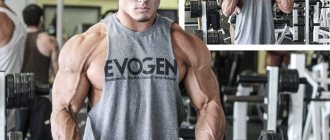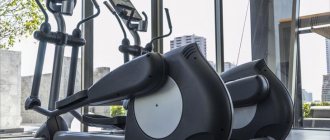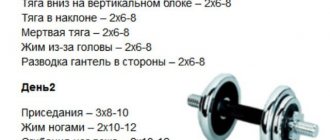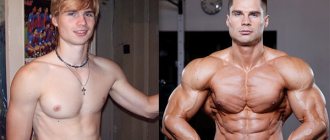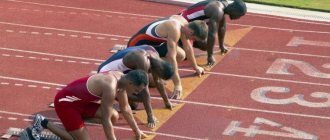The simple, but at the same time complex “Powerlifting” program of Boris Ivanovich Sheiko is distinguished by its severity and limited diet. This book provides answers to all questions not only of young, but also of experienced athletes. The author is an authority on powerlifting, although not everyone understands or follows his program.
The main advantage is that there are exercises for different levels of training of athletes, so that absolutely anyone can choose the most suitable regime for themselves. Basic rules immediately make it clear to a person what kind of load awaits him in the future. Therefore, the author himself and other experienced athletes strongly recommend reading the book from beginning to end, without avoiding the introduction and conclusion. Otherwise, the program will not be implemented at a sufficient level, which is why it will not be possible to achieve the desired result.
Boris Ivanovich Sheiko
Boris Sheiko rightfully received the title of Honored Coach of the USSR in powerlifting. “Powerlifting” is his training method for dischargers, which helps not only physically, but also mentally get in shape for upcoming competitions. In total, several books have been published where an experienced athlete and coach shares his own unique methods of planning exercises for athletes.
Tips for beginners
Classes are carried out strictly under the supervision of a trainer or experienced athlete. There is a classic 5x5 training scheme. For it, they use such a weight that it can be used to perform five techniques of 5 approaches. The procedure for calculating weight for training:
An athlete benches 100 kg and wants to achieve another 100. To perform 5x5 exercises, you need to use no more than 80 kg. It is necessary for a beginner to train by feeling, but not by force. The first four exercises are light, then one heavy weight. They do three workouts a week, one of which is hard.
Powerlifting Sheiko
This program provides for unloading of athletes, during which the intensity of the loads is slightly reduced. Sheiko's powerlifting training operates according to the student system, that is, if nothing has been imprinted in your head over the past semester, then you will not be able to learn it in a couple of days. This methodology is constructed in exactly the same way: if over a certain period of time an athlete was unable to accumulate the strength to win a competition, then the last couple of weeks will not correct this.
In fact, trying to achieve the necessary results in a few days after a long rest will only make the situation worse and deprive the already small amount of energy that will have to be restored again. The moment when the athlete truly reaches the very peak of his own physical fitness should be clearly defined and held. A coach can best help you in this matter. After all, it is he who is obliged to convey to his ward the value of all the efforts spent and direct him on the right path.
Basic and additional exercises
The classification of physical exercises is a specific system of their distribution into clear groups, as well as subgroups. This distribution occurs solely on the basis of existing characteristics. The theory of physical education and Sheiko’s “Powerlifting” distinguish three main groups of exercises for absolutely any sport:
- Competitive.
- Specially preparatory.
- General training.
The first group includes exercises that are included in the competition program and are used during training. The competition ones include the main ones: squat with a barbell, bench press (horizontal position), deadlift.
The second group consists of exercises that are mainly aimed only at studying and then improving individual elements taken from the techniques of the competitive group. In addition, thanks to the special training system, athletes have the opportunity to develop their own physical qualities, which is very important for a professional athlete. Strength, endurance, flexibility and other qualities should always be present in a worthy athlete. The program includes lead-up exercises: squats, bench presses, and deadlifts.
It should be noted that any exercise is considered a special preparatory exercise only if it contains factors quite similar to the competitive one.
Among other things, the second group is divided into introductory and developmental exercises, depending on the focus. The former contribute to the development of the form and technique of movements, while the latter are directly aimed at developing those very qualities of an athlete. It is worth remembering that developers have a local impact.
Exercises from the third group are used to increase the overall level of physical fitness of the athlete, as well as to develop individual muscle groups. The list of general preparatory exercises includes: exercises with a barbell, acrobatic, on simulators, gymnastics, with weights, shock absorbers and dumbbells. All of them help the athlete to develop diversified. In terms of technical parameters, this group has significant differences from the previous two. Competitive and special preparatory exercises are considered to be the basis, and general preparatory exercises are only an addition. It follows from this that they should be analyzed and adjusted to one’s own strengths in different ways.
Bench press training[edit | edit code]
Yuzhakov Anton All about the bench press
Yuzhakov Anton Close grip bench press
Yuzhakov Anton How to warm up for bench press
Bench press
The program for increasing bench press results is suitable for athletes of intermediate level and above. Author:
Svyatomir
Notes[edit | edit code]
- This program is designed to train the “top” and improve results in the bench press, since it was compiled for a forum member who does not set himself the goal of progressing in squats and deadlifts. It is very close to the Louis Simmons training and was compiled by me for the successful use of “naturals”.
- If you already bench press 120-130 kg, you can start.
- The duration of the program is 18-20 weeks (or more, depending on progress) with 2 workouts per week.
- At this stage there are no board presses and statics (there will be statics if the requirements specified in “workout 2” are met). They may be needed in the future.
- Since you are not going to train the bottom, and this is highly desirable, include very light squats as a warm-up at the beginning of Workout 1, and perform deadlifts every 2 weeks, as indicated in Workout 2. If you don’t want to pay attention to the “bottom” at all, there’s no need, but then replace the deadlift with shrugs with a standing barbell in the 50%*8, 75%*6 + 2*6-8 mode.
- After this program you will need to squat with a barbell in any case because... The lifting press technique requires strong hips. Caviar - as needed.
- Hyperextensions are performed once a week to prevent compression of the spine in the “bridge” during heavy bench presses (“workout 1”).
- The workouts will be long, up to an hour and a half - there’s no rush. Perhaps you have not trained like this before and at first it may seem very voluminous. I painted the volume according to “natural” realities; It won’t be easy, but in 3-4 weeks you’ll get the hang of it.
- Every 4 weeks you should add 3-4 days of rest i.e. “shift” the training by one workout or give a full week of rest every 5-6 weeks.
- A strong grip is important; if it is not strong enough, hang from the horizontal bar at every workout, and not just at the end of “workout 2.”
- If necessary, adjust your bench press technique using information on PL websites and training from more experienced lifters. Don't try this singles program without perfecting your technique.
- Warm-up percentages are indicated for calculation at the beginning of the program. Do not change the warm-up weights until the end of the program, or decide for yourself when to increase them slightly. The main thing is to warm up and not get tired before working approaches.
- The “back room” varies periodically, which makes it possible to progress for a long time and without “stagnation”. In the “auxiliary” exercises you will need to work as hard as possible.
- By following the program exactly and taking into account all the recommendations outlined, you can count on a minimum increase in bench press of 7.5 kg within the specified period (i.e. in 5-6 months, including additional days of rest). In the case of a successful “pressing” structure of the shoulder girdle and a favorable situation (nutrition, rest, minimal extra-training stress, etc.), the increase can reach 10-12.5 kg (especially if you have not trained like this yet and are currently only benching 120 kg). I created a similar program for one of my friends, who increased his 1RM in the bench press by 10.5 kg in 5 months (from 122.5 kg to 133 kg).
Program[edit | edit code]
Workout 1
1.
Bench press (speed, weight 60% of 1RM) - very light warm-up * 8, 5 * 3 (60% of 1RM) + 1 * 3 with a weight of 10-12.5 kg more than 60% (monitor if the speed does not drop bench press).
- This 60% is constantly recalculated depending on the record bench press in the 2nd workout. Be sure to use small pancakes or homemade “makeweights”.
2a.
Bench press with a narrow grip (40cm between the palms) - 60% * 5, 2 * 4-6.
2b.
Shoulder press from the chest (standing or sitting) 50-55%*5, 2*4-6.
Alternate options 2a and 2b every workout. If you have very strong triceps, but do weak chest presses while standing/sitting (for example, 70-75kg*5 from the chest with a bench press of 125-130kg*5) - perform each such workout only option 2b (preferably standing, pushing as necessary) . In this case, every 4th workout, replace the front chest press with a seated dumbbell press or barbell raises from the floor - 40% * 6, 70% * 6 + 2 * 5-6.
2a(+)
.
Sitting dumbbell flyes with a slight tilt of the body forward - 2 * 6 (in the 2nd approach, do partial repetitions until you can lift only 1/3 of the amplitude). 2b(+)
. Extensions on the upper block while standing (preferably with a rope, not an adapter) - 2 * 6-8.
Alternate options 2a(+) and 2b(+) during each workout. These are optional exercises, but they are desirable for variety.
If you don’t want to, don’t do it, but then add 1 approach to option 2a (you’ll get 3*3-5, not 2*4-6), and after option 2b do a vertical front row (standing, with a medium grip; pull the bar to the bottom chest) - 1*8-10.
3.
Pull-ups to the chest with a grip slightly wider than shoulder width - 1*6 without load, 1*6-8 with load, 1*max without load.
If your own weight is high and you can’t do a full pull-up, do the same on the upper block with 2 warm-ups + 2*6-8. IMHO, pull-ups are a priority.
4.
Bent-over barbell rows - 40%*6, 60%*6, 2*5-6 + partial repetitions in the 2nd approach. Watch your technology!
Do this exercise for 2 weeks after pull-ups, and another 2 weeks before them, etc. When pull-ups follow the rows to the belt, do 2*max pull-ups without a load on the belt and that’s it.
5.
Hyperextensions - 1 * 8-10 without a load + 2-3 * 8 with a load behind the head or in lowered hands (you can take a small barbell).
6.
Full-amplitude “twisting” while lying down with legs secured and a load behind the head - 1*8 without load, 1*6 (5-10kg) + 2*6-10.
Workout 2
1.
Bench press (power, singles) - 40%*8, 55%*5, 70%*1, 80%*1, 90%*1, 100%*1, record*1.
- Small gains of 1-0.5 kg (from workout to workout) rule here, so get the appropriate pancakes or small homemade “makeweights”. Don’t even try to try to gain 2.5 kg at once! When going for a record, you need to know that you will probably press the weight. Failed attempts to squeeze more will lead to a “rollback” of the scales. If you are very tired that day or simply don’t feel “raring to go”, postpone the workout or consolidate the result of the previous record.
Rest between work sets for 4-5 minutes or more.
- A high-quality general warm-up with light stretching of the pectoral muscles and general warm-up is a must. The insurance of a knowledgeable partner goes without saying. Working in singles is dangerous for ligaments and joints, so if you experience any discomfort, stop training immediately! You probably don't need a shoulder injury, a torn anterior deltoid, or a torn pectoral muscle. In general, do not start this program if you do not have experience in singles!
2.
French bench press - 40% * 8, 70% * 5, 2 * 8 (the one for whom the program was written will prescribe the approaches/repetitions if he wants differently).
- IMHO, sooner or later, a regular French press will hurt your elbows. In this case, it is better to do it while lying on the floor, powerfully tearing the barbell standing behind you up and quickly lowering it, dropping it to the floor behind your head. In this case, do 3*5, which will give functional strength to the triceps in the bench press. The result is an incomplete amplitude because the bar is 22.5cm from the floor due to the large plates, but that’s how it should be.)
3a.
Press from the plinths (lifting the barbell from the plinths from a position just above the “dead center”) - 1*1.
The weight will be much less than in the 1RM (figure it out for yourself; try it in the 1st lesson and in no case overexert yourself by choosing an adequate weight). 3b.
Dumbbell bench press at an angle of 30″ - 1*15-20 to failure or regular push-ups from the floor - 1*max. Press dumbbells or do push-ups at a moderate-fast pace.
- Alternate options 3a and 3b every workout.
- You can not do exercises 2 and 3 at all, replacing them with static holds of the barbell while lying down (at each such workout) - 3 * 12-15 seconds. This will allow you to thoroughly strengthen the ligaments and confidently progress in the bench press. If you have not previously practiced statics, start with a weight that is 10 kg less than 1RM (in the bench press) for the 1st approach and add 5-7.5 kg in each of the next two approaches. Each workout, increase the weight in all approaches by 2.5-5 kg depending on your strength. Limiters (power frame, etc.) must be installed 5 cm below the bar. If there is no load frame, racks with limiters or plinths, don’t even try to use statics! Working weights will soon become much higher than 1RM, and a barbell crushing you is a guarantee of injury (at best).
4a.
Parallel grip row on the upper block or overhead row (choose one option that is convenient for you) - 40% * 6, 70% * 6, 2 * 6-8
4b.
Deadlift (for general development) - 40%*8, 60%*5, 80%*3, 2*5-6 (don’t force it, but watch your technique; try to pull with your legs).
- Alternate between options 4a and 4b each workout, or do shrugs instead of deadlifts as indicated in the notes.
5a.
Standing straight bar curls - 40%*6, 70%*6, 2*5-6 + “hammer” 1*5-6
5b.
“Hammer” - 40%*6, 70%*6, 2*5-6 (if on this day you decide to perform shrugs rather than deadlifts, do “hammer” curls not 2*5-6, but 3* 5-6.
- Alternate options 5a and 5b every workout.
6.
Full-amplitude straight leg raises while hanging on the bar - 1*max + 2 sets of hanging until “you fall” to strengthen your grip (if it’s easy, wrap a towel around the bar).
Bench press
This exercise is universal, as it is involved in two main groups. As a competitive exercise, it is performed exclusively on a horizontal bench. The barbell is clearly fixed in straightened arms and, at the judge’s command, it must be lowered to the chest, make a visible pause, and then press it onto straightened arms.
As a special preparatory exercise, the bench press can be performed both on a horizontal and on an inclined bench. It can also be done not only with your head up, but also on a reverse incline bench. In this group, dumbbells can replace the barbell.
Sample training plan
Each person can try to perform the basic exercises that Sheiko’s “Powerlifting” program provides.
Workout 1
| № | Exercises | Number of approaches | Weight, % | Repetitions |
| 1 | Bench press | 1; 2; 2; 4 | 50; 60; 70;75 | 5; 4; 3; 3 |
| 2 | Squats | 1; 2; 5 | 50; 60; 70 | 5; 5; 5 |
| 3 | Bench press | 1; 2; 4 | 50; 60; 65 | 6; 6; 6 |
| 4 | Dumbbell raises | 3 | 5 |
Workout 2
| № | Exercises | Number of approaches | Weight, % | Repetitions |
| 1 | Deadlift | 1; 2; 2; 4 | 50; 60; 70; 75 | 5; 5; 4; 3 |
| 2 | Bench press at an angle | 4; 6 | 4 | |
| 3 | Dips | 4; 5 | 4 | |
| 4 | Ab crunches | 3 | Maximum |
Training program to increase bench press results
When you have decided on your own repetition maximum, you can start training.
First training
- 1. Bench press (60% of 1 repetition maximum) – 1 warm-up set + 3 working sets of 5 repetitions – performed at maximum speed, training explosive strength;
- 2a. Close-grip bench press – warm-up set + 3 working reps of 5 reps – we also work in speed mode, strengthening the triceps and inner chest;
- 2b. Standing barbell press – 1 warm-up set + 3 working sets – strengthening the anterior deltoid muscles.
Options 2a and 2b are used alternately (in one workout only 2a, in the other only 2b). But if some muscle group is lagging behind you (triceps or deltoids), then use one of the options more often.
- 3. Wide grip pull-ups - 1 set with only your own weight for 7-8 repetitions, 2 set with additional weights for 6-8 repetitions, and the last set again with your own weight for the maximum number of repetitions.
- 4. Bent-over barbell rows – 2 warm-up sets + 3 working sets of 6-8 reps.
Positive feedback about the program
Like any book, Sheiko’s Powerlifting method has reader reviews. Fortunately, there are much more positive opinions from beginners and professional athletes than negative ones.
Many people note that this book helps to learn information about muscles that not only athletes should know for sure. This technique describes the training in detail, as well as additional material. In addition, each exercise is illustrated, and a person will be able to perform them correctly.
Another important fact is that the book describes the methods of world athletes. Many novice athletes strive to follow the example of those who have achieved considerable success in sports. Therefore, this section is not superfluous in the book. Sheiko's Powerlifting program attracts attention with excellent content that is understandable to everyone.
It should be noted that there are quite a large number of readers who became interested in powerlifting and started playing sports after reading it.
Sheiko's training methodology: interview with Alex Nikulin (Denis Piklyaev)
Rate this post
With a series of articles under the general title “OUR METHODS,” we begin to introduce readers to the most famous and popular training systems in powerlifting. Prominent representatives of these methods, their creators, and famous athletes express their expert opinions.
Today we will talk about the training method developed by Boris Ivanovich Sheiko, which has received worldwide recognition, with Boris Ivanovich’s student Alexei Nikulin (Russia, Dzerzhinsky) - (editor’s note - WRPF PRO athlete, Elite of Russia, all-timer).
— Tell us about the training methodology that you support: when it was created and by whom, its characteristic/distinctive features, prominent representatives.
A.N. So, today we will talk about B.I.’s training methods. Sheiko, I’ll make a reservation right away, as I personally see it. There is personal experience here from the time I came to this sport more than 15 years ago, as well as now. It so happened, which I am undoubtedly glad of, more than three years ago I was lucky to start working with Sheiko B.I.
This system takes its roots from weightlifting, an excellent basis for such a young sport, which has grown into an independent sport with its undeniable pros and cons. More than one generation of great champions has grown up under this system.
Some of the most prominent representatives: A. Sivokon, R. Kazakov, S. Mor, V. Furazhkin, F. Mukhamatyanov. By the way, Alexey was an example for me when I came to this sport, the level that he demonstrated defied explanation and imagination. There was one thought - this person does not know about gravity.
What makes this system attractive is, first of all, its fundamentality, integrity, and consistency. When you look at all these numbers, you understand that everything is thought out to the smallest detail. Yes, undoubtedly, sport is not mathematics, and here we are dealing with the body of an individual. Everything has been thought out, from work in the off-season, to the competitive cycle and, of course, immediate unloading before the competition.
As a rule, all work is built in two coordinate systems: intensity and volume. Both in a single exercise, and for a workout, a week and a month. All work usually takes place in the range from 70% to 85%, in a dosage of 2 to 5 repetitions, if we take basic exercises, and when we do not use a special leading exercise. For example, pauses, chains, rubber. Here the work is built correctly from 60% to 75%, in a dosage of 2 to 5 repetitions. The number of workouts is usually 3-4 workouts per week. If we take into consideration a 4-day training system, then the division by exercise is as follows: day 1 – squats and bench press, day 3 – deadlift and press, day 5 – squats and bench press, day 6 – deadlift and bench press. Training takes place every other day and the 4th training is paired. Amount of assistance: 2-3 exercises per workout, the higher the intensity of the training process, the less the amount of assistance decreases. I also cannot note that Boris Ivanovich puts technology at the forefront, i.e. The exercise must be performed correctly. Only thanks to the combination: technique multiplied by technique, in three years of work I have not had more than one sports-related injury.
Yes, there are many opponents now, and not only now, of this program. It’s complex, it’s for the gifted, it’s for chemists, and so on... “But of course, I still need to work, go to a disco, smoke a hookah!” There is only one answer: any system from which a potential consumer wants to get results requires one foundation - hard, systematic work. A great result is a huge work, I will say more: systematic, which requires discipline and understanding of one’s goals from the individual. If you are not ready to endure and move forward, then this is not for you. If you need motivation, then you are busy with something other than your own business. You can't be on time everywhere.
Any success is a system of measures, it is an honest and sincere attitude towards what you do. You must clearly understand that this is exactly what you need, and not because it is fashionable or training for photographs or medals.
— Tell us about how you yourself progressed through this system? And why did she attract your attention?
A.N. I had two acquaintances with the B.I. system. Sheiko. At the beginning of your studies. I was involved in triathlon, and then weighed about 65-66 kilograms. A little easier than now. I studied under the guidance of my friend, who brought me to the gym. The basic system was taken to train Muravyov, since he himself studied on it and trained me on it.
But the bench press was a complete disaster: the first competition - the bench press was 87.5 kg, a year later it was 100 kg... And then my bench press froze between 100-105 kg. And we finally decided to change the system in the bench press; we searched for a long time for some information. At that time there was not much information.
In fact, there were two conventionally large resources: “Powerlifting from A to Z”, Pashki Lukashin (Khomyak) and “Powerlifting.ru” Alexey Kurkov (Tatarchaga or Honored CMS). Subsequently, the resources pooled and became the habitat of all athletes involved in powerlifting. Eh, there was a time, it was a good time...
This resource aggregated information, and there were also active athletes and specialists on the forum who always helped. Also, I took training plans from the Irbis club website. Just at that time B.I. Sheiko led it, if I remember correctly, everything was exactly like that. Much water has passed under the bridge since those times.
So, in fact, we combined two programs: Muravyov’s and for the bench press B.I. Sheiko. for those who like to plow. And within a year, my numbers grew from 100-105 to 135 kg, in the same category. Then there was a break in my powerlifting classes for domestic reasons. And again I returned, but working directly with Boris Ivanovich from January 5, 2020.
Regarding my results, we do not take into account the training ones, because the indicator is the dry numbers in the protocol. Consistently, over the first six months and the first start, we increased the squats from 300 to 315 kilograms, as it is now fashionable to indicate “with bare knees” (sounds like a nudist). In total from 770 to 785 kilograms. Then, at the end of the year, we were able to increase the squat in bands from 335 to 345 kilograms, this was the month of December. In 2020, I will be able to update my result in squats and stood up with knee pads at 340 kilograms, at the moment this is my best result. And for the first time I crossed the 800 mark, which I had not conquered for so long, and I eventually collected 822.5 kg. This was the city of Suzdal. Also at the end of the year I will be able to update my amount; in December I recorded the amount of 832.5 kg.
And what attracted me to the work on Sheiko is an interesting question. Who has known me for a long time, and especially personally. I like to train hard, or rather, very hard, this is my, let’s say, wave, my element, where I feel comfortable. A large amount of work, but not a lot of repetitions per approach, that’s for me.
— How suitable is this technique for a triathlete competing in the equipment/RAW divisions, an athlete specializing in one movement?
A.N. This program is ideal for non-equipped eventing. For beginners, in my opinion, the ideal option: a huge number of basic and specially leading exercises. There are examples of programs online for athletes of different levels. There are also highly specialized systems, such as the bench press. Again, if you look at Boris Ivanovich’s students, among those he trained were both triathletes and bench press specialists. Actually, these programs are adapted to any task in the powerlifting segment with a shift to one movement or another.
— The relevance of auxiliary/auxiliary exercises in this technique?
A.N. Auxiliary exercises and specially leading exercises should be present in sufficient quantities. Again, we will not cover the range of tasks and problems that this sport poses with the base. Again, we must ensure the holistic development of all muscle groups that are involved in the work process, without obvious distortions and weak muscle groups that will lead either to injury or to ineffective use of one’s own body.
There is one thesis that correctly reflects reality: “the weakness of a system is determined by its weakest link.” In other words, you need to work on all muscle groups, from biceps to abs. Of course, by setting the right priorities based on your tasks, so that you do not end up becoming a back-room champion.
You often see deadlifts from plates that exceed personal maximums or bench presses by several times. One thought always comes through clearly: extra work. Any exercise should be aimed at improving the basic; it cannot be considered separately from the basic ones.
— What and will there be differences in training for an athlete training “with vitamins” and without them when preparing using this method?
A.N. So, we come to the most interesting question for the audience. Because now any type of training is associated with the use of drugs. Unfortunately, a steady trend has developed that before I had time to step into the gym, it’s time, I’ve exhausted my natural potential. You have to learn to work, work hard and also recover. Everything in due time, it should be an objective and conscious decision, and not because “I want it quickly and yesterday.”
Of course, there are differences; first of all, any program is not a dogma, but only a template and representation of a general path, which, of course, changes during the training process. The body is not a machine, and the well-being and general condition of the body is influenced by a lot of factors that it is advisable to take into account.
If we take the general idea and consider a specific training, then I would take a three-day training system, first of all, if an athlete of the plus category, then I would train not every other day, but two days later on the third. This is the first thing I would do if there were problems with recovery. Second, you might consider reducing your overall intensity.
It’s difficult to give a universal recipe, since there are a lot of examples where guys “on their own” did something that guys “on vitamins” couldn’t. The adaptive functions of the body are very individual in nature and, of course, they can be developed.
— How many times a week, in your opinion, is it best to train using this system? Or is it better not to start with a standard week? What can you say about the length of the cycle - which, in your opinion, is the most optimal in terms of time?
A.N. The most universal and suitable program for everyone, and especially for starting to work with this technique, is 3-day training. This is day 1: squat-press, day 3: deadlift-press, day 5: squat-press. Training takes place every other day.
As you adapt to this program and the individual’s technical skill grows, you can smoothly and systematically move on to 4-day training. Again, carefully increase the load without sudden bends. Unless, of course, your training will be modified relative to the standard schemes that are published.
The optimal length of training, based on my experience, is 12-16 weeks, which is quite enough. In short, I think it doesn’t make sense, since you need to lay the foundation for a future result, and this requires time and a lot of work. I am a supporter of long preparations, this is 5-6 months, I like it better: you can gain positive work experience and already with this amount of work go to the stage.
— Can you describe the plan in %, say, for a standard 12 weeks for a triathlete with results: 200-150-200? If readers are interested in this system, where can they look for more detailed information?
A.N. These typical schemes have been published on the Internet, and each of you has seen them more than once, and I think it will not be difficult to find and use them. There are also xls files where you can enter your personal maximums and the program will have your numbers.
The text was prepared by the SPR/ WRPF correspondent unit.
Similar
Author's shortcomings
As mentioned above, Sheiko’s powerlifting training plan has virtually no negative reviews. For arresters, he presents a good manual with decent recommendations. The only thing that athletes note is too weak or too strong loads. But we should not forget that for each person the additional weight and number of repetitions must be calculated separately. Therefore, the author did not notice any particular shortcomings, and all the material presented in the program motivates athletes to new victories. In Sheiko’s book “Powerlifting,” absolutely anyone with desire and willpower can progress from beginner to master.
Basic mistakes in preparation
- Up until 3-4 weeks I did squats and deadlifts in a jumpsuit without straps. This had a good effect on the strength of my back, but I was unaccustomed to the technique of exercises in straps. At the squat competition it cost me 20kg: I squatted 240 for the test, and didn’t finish 260, although it was easy to get up.
- As usual, the passion for cravings has dried up a little. When I pulled 260, I felt the advantages of the loads that my back experienced without straps.
- I missed the last week because... there were competitions before. I think I could do some heavy lifting in the straps this week.
- I practically didn’t bench press in a T-shirt. When I started to press, different people put it on me. Accordingly, she sat differently each time.
- My Katana Extreme is 1 size too small. This made it very difficult to master the bench press technique. I had to take a larger T-shirt to understand anything.
